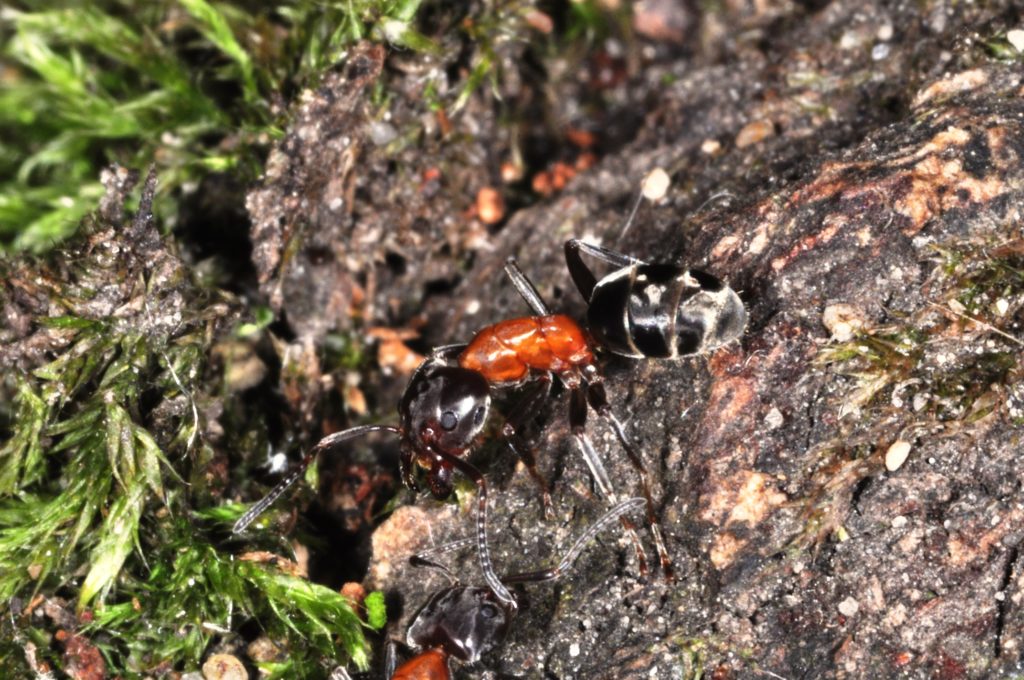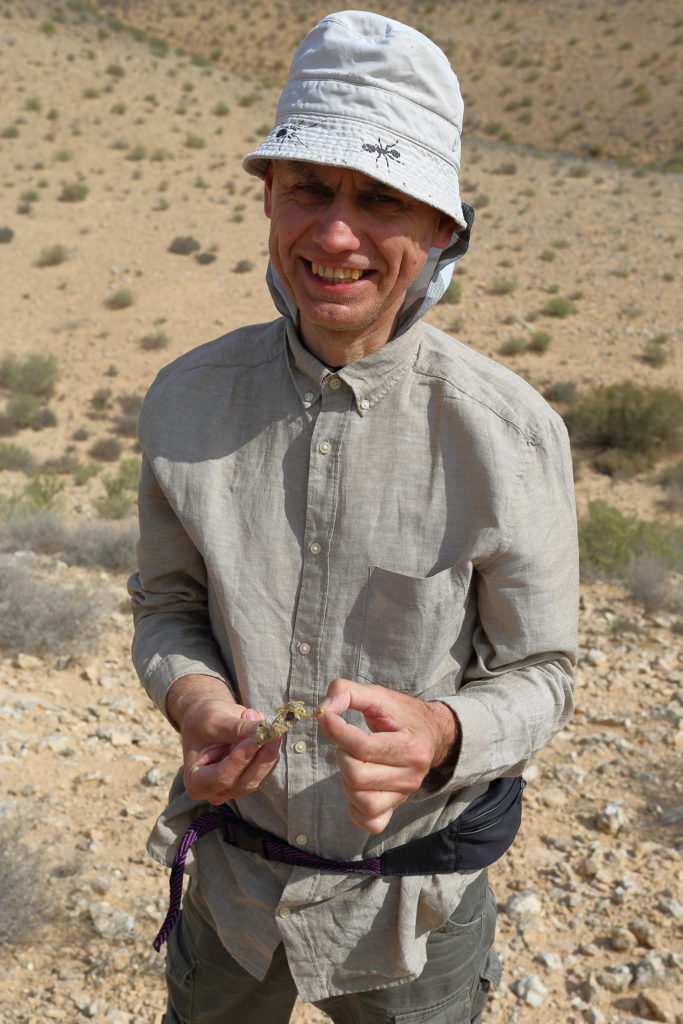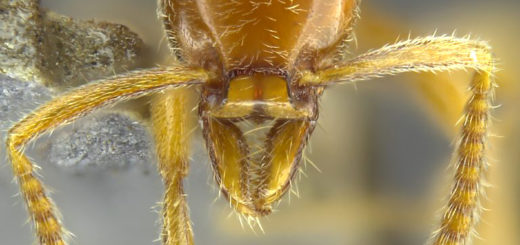Ant-mimicking spider actively selects its mimetic model
Stano Pekár is a behavioural ecologist and arachnologist at the Masaryk University in the Czech Republic. He focuses on the interactions between predators and their prey. In the recently published article “Ant-mimicking spider actively selects its mimetic model (Araneae: Gnaphosidae; Hymenoptera: Formicidae)” in Myrmecological News, he revealed the interaction between the ant-mimicking spider Micaria sociabilis and its model Liometopum microcephalum. Here, he shares the main points of his study as well as some pictures.
An Interview compiled by Patrick Krapf

MNB: Could you tell us a bit about yourself?
SP: I consider myself a behavioural ecologist with a main focus on the interactions between predators and their prey. I was trained as an arachnologist, so I mainly work with spiders, which are often the predators. However, in some cases, they act as prey. To study these interactions with my team we combine ethological and ecological methods with morphological and molecular approaches, for example. We are focusing currently on three major areas: Firstly, defensive strategies of spiders, namely evolution of Batesian mimicry, which is an imitation of an unprofitable organism in order to gain protection from predators. Another topic my team is working on is the evolution of prey specialization in spiders. Some species of spiders feed only on specific prey such as ants, termites or other spiders. We investigate what adaptations have evolved to help spiders to improve the prey-capture efficiency. The third major topic is related to agriculture. We study the role of spiders in controlling insect pests. We aim to develop methods that help to improve the efficiency of spiders in doing so.
MNB: Wow, such a variety! And how many people are working in your group?
SP: Currently, there are about 10 people on my team. But this is changing all the time as it depends on the number of students. There are bachelor, master and PhD students as well as postdocs in my group.
MNB: Now regarding your work recently published in Myrmecological News. Could you briefly outline your research in layman’s terms?
SP: We were focusing on one spider species that does not look like a spider but rather resembles an ant and behaves similarly. We think this is because it is using Batesian ant mimicry, which means it tries to avoid being eaten by the predators by pretending to be an ant. Why ants? Well, ants are generally avoided by many generalist predators, because they have a series of defences: They can bite, some can sting, they can make a grouped attack, and they often have a slender body, so they are really unprofitable. There are quite a few spider species, which try to imitate ants in their morphology, that is coloration, body shape but also in their movement. Some ten years ago, we came across one spider species, Micaria sociabilis, which is quite rare and has been described more than a hundred years ago, but since then it was rarely found. We found that it occurs only on trees where also Liometopum microcephalum ants are living. So, we designed a study to see whether this ant-mimicking spider is only associating with a single ant species or with several species. You know, the coloration of this spider is black and orange so it may resemble the coloration pattern of L. microcephalum, or several Formica ant species. We surveyed almost a hundred trees in one area in southern Moravia, and we recorded whether there is Micaria present on the trees and which species of ants are present on the same tree. And we found that Micaria spiders exclusively associate with L. microcephalum. That means they do not occur on trees where the ants are absent, and they occur only on the trees where L. microcephalum is present. So there is a very strong association with a single ant species. Next, we wanted to know how this is possible. Are the spiders able to locate specifically L. microcephalum ants or could the common occurrence be a result of selection pressure by predators? Predators such as birds could easily recognize the spiders if they mimic an ant of a different appearance, and therefore, Micaria spiders would only be found with the ant species they look alike. So, we conducted a laboratory experiment, to investigate whether spiders can recognize some pheromones of ants and, by these means, track their occurrence. In the lab, we used olfactometer, which is a simple Y-shaped device. The spider was then exposed to different cues produced by ants. For this purpose, we selected two most common ant species to see whether the spiders are able to distinguish them or not: L. microcephalum and Lasius fuliginosus. We hypothesized that they might alarm or trail pheromones. We observed that Micaria spiders did not show any response to chemicals carried by air, possibly alarm pheromone, but they responded to chemicals deposited on the substrate, most likely the trail pheromone. The spiders avoided cues from L. fuliginosus but were attracted to cues from L. microcephalum. This means that the spiders are actively selecting the trees were Liometopum is occurring and could recognize the presence of these ants. Thus dispersing Micaria spiders that, for some reason, land on a tree where other ants are present, would avoid that tree and try instead to go to another tree where Liometopum ants are present. This is the story that we have discovered.

MNB: Wow, that is really fascinating! And just to be clear, these spiders never prey on the ants, right?
SP: Yes, these spiders, as most other ant-mimicking spiders, do not feed on their model. The ants are very dangerous. The spiders are as big as the ants, and because there are hundreds of ants, they could easily kill the spider. The spiders instead feed on some tiny arthropods like collembolans or flies that land or live on the bark of a tree.
MNB: And I guess the spiders are actively avoiding the ants as well?
SP: Exactly! You would never see an encounter of an ant-mimicking spider with an ant. As soon as an ant approaches a spider, the spider quickly runs away! The ants are foraging in columns on the bark of a tree, and the spiders are not inside the trails but on the outside of it, so very near to the trail but never in direct contact with the ants.
MNB: Right before, you mentioned that in your experiment with volatiles you used L. fuliginosus. Do you think that the spiders disliked their trail pheromones or volatiles? I merely ask because L. fuliginosus is known for its chemical repellent.
SP: That is possible. We only found that spiders avoid the cues, but we were not able to identify which of the chemicals are then the actual signal. We did not go that far.
MNB: So that would have gone beyond the scope?
SP: Yes, that is going to be the aim of a future study.

MNB: What is the take-home message that you would like people to know from this study?
SP: The main message is that M. sociabilis actively select its model, in this case L. microcephalum. This has never been shown before for any ant-mimicking arthropod. Not only because there are very few studies on mimicking spiders. As far as we know, nobody has studied whether a Batesian mimic is actively selecting its model or not. We were, of course, lucky as ants are rather easy to study because they communicate chemically. In hoverflies, which are, for example, Batesian mimics of bees, this topic is probably very difficult to study because they fly around and there probably are not many chemical traces around that hoverflies could use. So it might be actually very difficult studying this in other cases of Batesian mimicry.
MNB: And what was your motivation for this study?
SP: Well, it was a combination of several factors. First, we have an ongoing project on mimicry, and this was one of the questions that we wanted to answer with this project. Why then M. sociabilis and L. micropehalum? This is because ant-mimicking spiders are usually very difficult to find in higher numbers that are needed for experiments. We realised that this pair is not that difficult to find in comparison with other ant-mimicking spiders that occur on the ground, for example, in the grass. In the grass, it is very difficult to spot them. So, a combination of these circumstances were the two major drivers.
MNB: Do you have any idea how many ant-mimicking spiders exist worldwide?
SP: Out of almost 50,000 spider species known, we have collected data for about 500 species. I assume that the number will probably increase with new species described because many of these mimics are occurring particularly in the tropics. There, the description of new species is still going on.
MNB: Wow, so many. And what was the biggest obstacle you had to overcome in this project?
SP: I think the major obstacle was to collect a sufficient number of individuals of these mimics. Finding L. micropehalum was easy because they are quite abundant. But finding the spiders was more difficult, and collecting them was a challenge. As the spiders occur on old oak trees, which have a very rough bark, they can quickly run away and hide into the bark ravines. It took us several days to collect about 30 individuals that we used in the experiment.
MNB: And I assume that the trees are quite high as well. So the spiders would move up quickly and then you would not be able to collect them?
SP: Exactly. These are huge trees, which are, 30-50 metres high. And we could not use a ladder as it would have been too dangerous. So we searched for them only in the area that is close to the ground, up to the height of 2 meters, not more. So that was quite limiting as well.
MNB: And do you have any tips for others who are interested in doing similar research?
SP: Similar studies would be very nice. I would expect that a similar ability to recognise its model is probably occurring, if not in all, then in many ant-mimicking spiders because it is very profitable for ant-mimics to occur near to the ants. I would like to see some future studies, which focus on other ant-mimicking spiders, to prove whether this is the case or not.
MNB: And you have also some projects currently in this direction, right?
SP: As I said before, we currently have an ongoing project which is focused on ant-mimicry. Within this project we also study whether ant-mimicking spiders imitate only a single model or several models. Micaria sociabilis seems to imitate only one ant species, but other ant-mimicking spiders seem to imitate several similar ant species. In that case, it is not known whether they are able to locate all of the ant models.
MNB: As I see it, there are still some unresolved questions, right?
SP: Yes, there is still huge potential for further research in this area, exactly.
MNB: In a future interview, who (researcher, PostDoc fellow, or PhD student) would you like to see featured?
SP: If I can name one from my working group, then I would say Lenka Dusatkova Petrakova. She is a PostDoc fellow who has been trained in myrmecology and has been working on L. micropehalum. She was studying interactions between L. micropehalum and Lasius ants. Currently, she is on maternal leave, but I think that when she is back, she would enjoy giving an interview.
MNB: Thanks for mentioning her! And thank you so much for your time elaborating on your interesting research.






Recent Comments